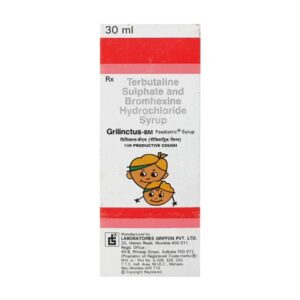BROMHEXINE + TERBUTALINE
Bromhexine: Bromhexine is a medication used to treat respiratory conditions such as bronchitis, cough, and other lung diseases. It is classified as a mucolytic drug, which means it works by thinning and loosening the mucus in the airways, making it easier to cough up and clear the lungs.
The main mechanism of action of Bromhexine is through increasing the production and secretion of fluid in the respiratory tract. This results in the liquefaction and easier clearance of thick and sticky mucus, helping to relieve congestion and coughing.
The recommended dose of Bromhexine may vary depending on the individual and the specific condition being treated. However, in general, the usual dose for adults is 8-16 mg taken three times a day. For children, the dose is usually lower and is determined based on their age and weight.
As with any medication, Bromhexine can have side effects. Common side effects may include gastrointestinal symptoms such as nausea, vomiting, diarrhea, and abdominal pain. Some people may also experience headaches, dizziness, or skin rashes. Rare but severe side effects may include allergic reactions such as difficulty breathing, swelling of the face or throat, and severe skin reactions. If any of these severe side effects occur, immediate medical attention should be sought.
It is important to note that Bromhexine should be used under the guidance and prescription of a healthcare professional. They will consider the individual’s medical history and other medications being taken, to ensure its safe and appropriate use.
Terbutaline: Terbutaline is a medication primarily used to treat bronchospasm in conditions such as asthma, chronic obstructive pulmonary disease (COPD), and bronchitis. It belongs to a class of drugs known as beta-2 adrenergic agonists or bronchodilators.
The primary mechanism of action of terbutaline is its ability to stimulate the beta-2 adrenergic receptors in the smooth muscles of the airways. This stimulation leads to the relaxation of the muscles, which helps to widen the airways and improve breathing. Terbutaline also acts on the beta-2 receptors in the uterus, leading to relaxation of the uterine muscles and it is sometimes used to delay preterm labor.
The dose of terbutaline may vary depending on the condition being treated and the individual’s response to the medication. It is commonly available in tablet form and may be taken orally with or without food. For bronchospasm, the typical dose is 2.5-5 mg every 6-8 hours as needed. In the case of preterm labor, the recommended dose is 2.5-5 mg every 4-6 hours for up to 48-72 hours.
As with any medication, terbutaline can cause side effects. Common side effects include tremor, headache, nervousness, dizziness, and increased heart rate. These side effects are usually mild and temporary. However, if they persist or worsen, it is essential to consult a doctor.
Serious side effects are rare but can occur. These may include chest pain, palpitations, rapid heartbeat, difficulty breathing, and allergic reactions such as rash, itching, or swelling. It is important to seek immediate medical attention if any of these severe side effects occur.
Terbutaline should be used with caution in individuals with certain conditions, such as heart disease, high blood pressure, diabetes, and overactive thyroid. It may interact with other medications, so it is vital to inform the healthcare provider about all current medications being taken.
Overall, terbutaline is a bronchodilator that is commonly used to treat bronchospasm and preterm labor. It works by relaxing the smooth muscles of the airways and the uterus, leading to improved breathing and delayed labor. While it is generally well-tolerated, it is important to be aware of the potential side effects and seek medical attention if needed.





